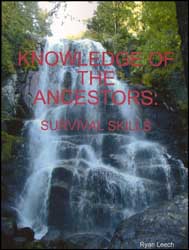Knowledge of the Ancestors: Survival Skills
Ryan Leech
Reviewed by Thomas J. Elpel
Knowledge of the Ancestors: Survival Skills is an astonishingly good book for an amateur writer and publisher. Although the cover shot, interior formatting, and fonts could be improved, the book has real substance in the range and depth of skills covered, including good text and photos of:
 Shelters: Debris hut, firebed, wickiup, snow pile shelter, and single person thatched shelter.
Shelters: Debris hut, firebed, wickiup, snow pile shelter, and single person thatched shelter.
Fire: Bowdrill, handdrill, strap handdrill, floating handdrill technique, mouth handdrill, and tinder.
Cordage: Making cordage from plant leaves, stalks, inner tree bark, roots, buckskin, intestines, rawhide, and sinew, including cording, braiding, and basic knots.
Containers: Simple baskets, twined baskets, coiled baskets, gourd containers, coal-burned containers, and an extensive section on birchbark containers.
Traps and Trapping: Figure 4 deadfall, Piaute deadfall, two stick deadfall, broken stick baited deadfall, baited string deadfall, basic snare, spring snare, lever and fulcrum snare, hooked snare, notched trigger snare, rock base snare, basic stick snare, notch plug snare, dowel snare, McPherson deadfall, goose ditch, pit trap, and platform trap.
Animals: This chapter is a miniaturized field guide to wildlife that doesn't significantly contribute to the survival content of the book, although the author includes lessons we can learn from each animal.
Processing & Preparing Food: Spit cooking, rotisserie, rock fry pan, mud cooking, rock boiling, primitive stir fry, steam pit, ash cakes, processing nuts, grains, and wild rice, using medicinal herbs, and processing small and large game.
Weapons and Hunting: Throwing stones, throwing sticks, sling, spears, primitive fishing, hunting and stalking.
Tools: Fire, bone, antlers, shells, pecking and grinding stones, discoidal blades, pressure flaking, torches, candles, vice, axe, adze, bowdrill, handdrill, digging stick, pitch glue, and sandpaper.
Plants: Edible, medicinal, and utilitarian uses are covered for amaranth, arrowhead, bergamot, blackberries, blueberries, bracken fern, bulrush, burdock, cattail, chickweed, chicory, clovers, dandelion, day lily, dock, evening primrose, goldenrod, grasses, green briars, Indian cucumber, Japanese knotweed, jewelweed, lamb's quarters, mallow, may-apple, milkweed, mint, mullein, ox-eye daisy, pennycress, pickeral weed, pineappleweed, plantain, pond lily, prickly pear cactus, purslane, reed, rose, shepherd's purse, stinging nettle, strawberry, sunflower, thistle, violet, wild asparagus, wild ginger, wild grapes, wild onion, wild raisin, wild rice, winter cress, wintergreen, wood sorrel, yucca. Poison hemlock and poison ivy are also covered.
Trees: Edible, medicinal, and utilitarian uses are covered for aspen, balsam fir, basswood, beech, birch, cedar, cherries, cottonwood, hemlock, hickory, maple, mulberry, oak, pine, sassafras, spruce, sumac, sycamore, tulip poplar, walnut, and willow.
Tracking: Tracking vocabulary, gaits, scat, tracking basics. As with the chapter on animals, this chapter might be better moved to a separate book.
Author Ryan Leech demonstrates a mastery of primitive survival basics throughout the book. It is an excellent beginning text for anyone wanting to learn wilderness survival living. Borders Personal Publishing. 320 pages. 2008.
Return to Granny's Country Store Home Page